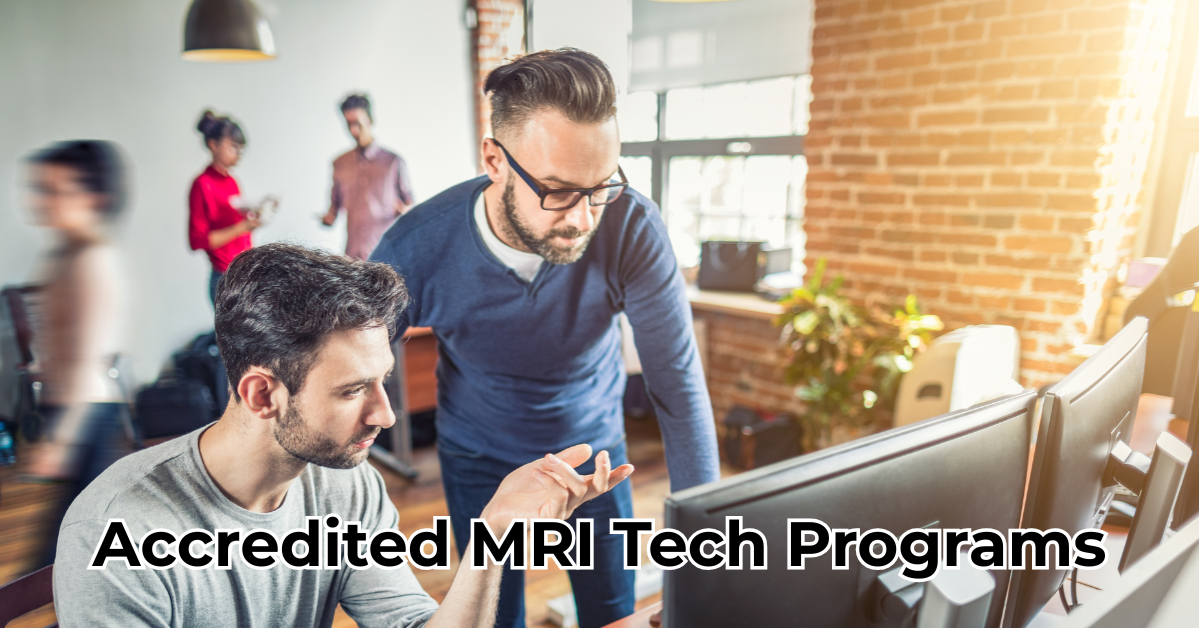One of the most rapidly expanding fields in medical imaging is Magnetic Resonance Imaging (MRI), and, as reported by the U.S. Bureau of Labour Statistics, the employment of skilled technologists is expected to grow by almost 7 per cent between 2024 and 2032.
With the growth of hospitals, diagnostic centres and outpatient facilities in offering imaging services, accredited MRI tech programs have proved to be the gold standard for anyone who wishes to venture into this lucrative profession.
They can be sure that they will get a good training by enrolling in a program that is accredited nationally, and that they can take the exams to get certified, and they may have an advantage in the employment sector.
Be it a new high school graduate or an employee in the medical field, needing to specialise, learning how accredited MRI tech programs operate in 2025 is the start of a well-compensated and solid career.
What Are Accredited MRI Tech Programs?
Accredited MRI tech programs are educational programs that are organised through educational programs to prepare students to work as MRI technologists.
Accreditation is when the program was assessed and accredited by one of the recognised bodies, like the Joint Review Committee on Education in Radiologic Technology (JRCERT) or Commission on Accreditation of Allied Health Education Programs (CAAHEP).
These accreditations ensure that the program complies with the industry standards, offers sufficient clinical education and qualifies its graduates to take the American Registry of Radiologic Technologists (ARRT) MRI certification exam.
Why Accreditation Matters
- Employer preference: Most hospitals and imaging centres hire only graduates of accredited MRI tech schools.
- Certification eligibility: ARRT requires students to graduate from an accredited program to take the national MRI technologist exam.
- Quality assurance: Accreditation ensures students learn advanced MRI protocols, patient safety, and ethical practices.
Program Formats
As of 2025, accredited MRI programs are available in several formats to fit different career goals:
- Certificate Programs – Typically 12–18 months, ideal for licensed radiologic technologists who want to add an MRI speciality.
- Associate Degree Programs – 2-year programs that combine general education with MRI-specific courses.
- Bachelor’s Degree Programs – 4-year programs offering broader medical imaging knowledge, leadership training, and research opportunities.
In moving to complete an accredited MRI tech program, students do not simply learn how to use imaging equipment so that they can operate it in the future, but rather, they are setting the framework of professional development over an extended period in a medical field.
Top Program Pathways in 2025: Certificate, Associate & Bachelor’s Options
In 2025, prospective MRI technologists have multiple academic pathways to choose from depending on their background, career goals, and time commitment. Each path has its own advantages, but all must be accredited to meet ARRT eligibility requirements.
Certificate Programs
- Length: 12–18 months
- Best For: Licensed radiologic technologists, nuclear medicine technologists, or sonographers looking to specialise in MRI.
- Focus: Fast-track training on MRI physics, cross-sectional anatomy, patient positioning, and hands-on clinical rotations.
- Example Schools: Mayo Clinic School of Health Sciences (MN), Johns Hopkins Hospital (MD), and Oregon Health & Science University (OR).
Certificate programs are the quickest way to transition into MRI if you already hold a credential in another imaging field.
Associate Degree Programs
- Length: 2 years
- Best For: High school graduates or individuals without prior imaging credentials.
- Curriculum: Combines general education (math, biology, communication) with MRI-specific courses.
- Career Outcomes: Prepares students for entry-level MRI tech roles and ARRT exam eligibility.
Popular examples include community colleges and state colleges that offer JRCERT-accredited associate programs.
Bachelor’s Degree Programs
- Length: 4 years
- Best For: Students seeking advanced career opportunities, leadership roles, or eligibility for management positions.
- Added Value: Includes research projects, healthcare management, and additional imaging modalities beyond MRI.
- Salary Advantage: MRI techs with bachelor’s degrees often earn 10–15% more than those with only an associate degree.
In short, whether you choose a certificate, associate, or bachelor’s program in 2025 depends on your career stage and long-term goals—but accreditation remains the non-negotiable factor.
How to Verify Accreditation: ARRT, JRCERT, CAAHEP, and School Checks
With the rising demand for MRI technologists, many programs have emerged—but not all are accredited. Students must take the extra step of verifying accreditation to avoid investing time and money in non-recognised schools.
Key Accrediting Bodies in 2025
- JRCERT (Joint Review Committee on Education in Radiologic Technology): The primary accreditor for radiography and MRI programs in the U.S.
- CAAHEP (Commission on Accreditation of Allied Health Education Programs): Accredits some MRI and medical imaging programs in collaboration with professional committees.
- ARRT (American Registry of Radiologic Technologists): While not an accrediting body, ARRT requires graduation from a recognised accredited program to be exam-eligible.
Steps to Confirm Accreditation
- Check JRCERT’s official directory (updated frequently with accredited MRI schools).
- Visit ARRT’s website for eligibility requirements tied to accredited programs.
- Ask schools directly: Request proof of current accreditation and the name of the accrediting agency.
- Look at outcomes data: Accredited programs publish statistics on graduation rates, ARRT pass rates, and job placement.
Warning Signs of Non-Accredited Programs
- Promises of “fast-track” MRI certification without clinical rotations.
- Schools not listed on JRCERT or CAAHEP directories.
- Limited or no published ARRT exam pass rates.
By carefully checking accreditation in 2025, students can protect their investment and ensure they qualify for high-paying positions in MRI technology.
Admission Requirements, Curriculum & Clinical Hours (What to Expect)
Before enrolling in an accredited MRI tech program, it’s important to understand the entry requirements and what the training involves. While requirements vary by school, accredited programs follow consistent standards to align with ARRT eligibility.
Admission Requirements (2025)
- High School Diploma or GED – Required for all entry-level programs.
- Prerequisites – Biology, anatomy, algebra, and sometimes physics.
- Background Check & Immunisations – Ensures compliance with clinical site policies.
- For Certificate Programs – Proof of existing ARRT certification in radiography, nuclear medicine, or sonography.
Curriculum Overview
Accredited MRI tech programs blend classroom learning with hands-on clinical training. Coursework typically includes:
- MRI Physics & Instrumentation
- Cross-sectional Anatomy
- Patient Care & Safety in MRI (including contrast agents)
- Pathophysiology and Imaging Procedures
- Radiation Protection & Ethics
Clinical Hour Requirements
Clinical training is a cornerstone of accredited programs. As of 2025, most require between 1,000 and 1,500 clinical hours, where students work directly with patients under supervision. These rotations provide exposure to:
- Brain, spine, abdominal, and musculoskeletal imaging
- Emergency and trauma scans
- Pediatric and geriatric patient care
By the end of the program, students are not only academically prepared but also have real-world experience, making them job-ready from day one.
Costs, Financial Aid & Typical Salary Outcomes After Graduation
Investing in an accredited MRI program can be costly, but the long-term return in salary and job stability makes it worthwhile.
Program Costs in 2025
- Certificate Programs: $12,000 – $20,000
- Associate Degrees: $15,000 – $35,000 (community colleges at the lower end, private schools at the higher end)
- Bachelor’s Degrees: $40,000 – $75,000+, depending on the institution

Financial Aid & Scholarships
- Federal Financial Aid: Pell Grants, subsidised loans, and work-study for eligible students.
- Scholarships: Professional associations like the American Society of Radiologic Technologists (ASRT) offer annual scholarships.
- Employer Sponsorships: Some hospitals cover tuition for employees pursuing MRI specialisation.
Salary Outcomes in 2025
According to the U.S. Bureau of Labour Statistics (updated May 2025):
- Median Annual Salary: $85,400 for MRI technologists.
- Top 10% Earners: Over $110,000 annually, often in metropolitan hospitals or specialised imaging centres.
- Entry-Level Salaries: Range from $60,000–$70,000 depending on location and employer.

Return on Investment
Given the relatively short duration of training (1–4 years), many students recover their educational costs within the first few years of working. MRI technologists also benefit from steady job security, as demand continues to grow with an ageing population and advancements in medical imaging.
Choosing the Right Program: 7 Practical Tips to Pick an Accredited MRI School
With dozens of accredited MRI programs available in 2025, selecting the right one can feel overwhelming. Beyond accreditation, students should consider factors like location, cost, and career outcomes. Here are seven practical tips to guide the decision:
- Confirm Accreditation – Verify the school through JRCERT or CAAHEP listings.
- Compare Program Lengths – Decide if a certificate (fast-track), associate (balanced), or bachelor’s (comprehensive) program best suits your career goals.
- Check ARRT Pass Rates – A strong pass rate shows program quality. Look for schools with 80% or higher first-time pass rates.
- Evaluate Clinical Partnerships – Ensure the program partners with reputable hospitals or imaging centres for clinical hours.
- Review Faculty Credentials – Instructors should hold ARRT certification and have years of MRI experience.
- Consider Location & Flexibility – Online hybrid programs are expanding in 2025, offering didactic courses online with in-person clinical rotations.
- Ask About Career Placement – Some programs boast job placement rates above 90% within 6 months of graduation, a strong indicator of employer trust.
Choosing wisely can make the difference between a smooth career start and unnecessary struggles in certification or job placement.
Conclusion
MRI tech programs are also one of the most promising careers in the healthcare system today that have a gateway to accredited MRI tech programs.
Students now can choose more than ever a fast certificate, a full-fledged associate degree, or a full bachelor’s pathway in the year 2025. Accreditation guarantees the program to be in compliance with the national standards, prepares graduates to take the ARRT exam, and leads to high-paying jobs in hospitals and imaging centres.
Having median wages that already exceed $85,000 a year and with demand expected to continue increasing, the choice to invest in an accredited MRI program will have lifetime benefits.
Through important assessment of schools, accreditation checks, and fitting the program to personal objectives, future technologists can fearlessly enter a profession combining technology, patient care, and professional development.
FAQs
What is the salary of an MRI technician in Pakistan?
In 2025, MRI technicians in Pakistan earn between PKR 800,000 to 1,500,000 annually, depending on experience, hospital type, and city.
What is the best degree for an MRI tech?
The best degree for an MRI tech is an Associate’s or Bachelor’s in Radiologic Technology, as both are accredited and qualify graduates for ARRT certification.
What is the fastest way to become an MRI tech?
The fastest route is completing a 12–18 month accredited MRI certificate program if you’re already a licensed radiologic technologist.

